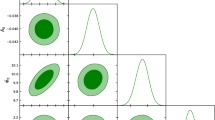Summary
On the physical basis that the gravitational deflection of light is finite, we show that the only possible rank for the gravitational potential in flat-space-time theories is two. Indeed, if the tensor rank is zero or unity (scalar and vector theories), the deflection of light is zero. If the rank is two, the deflection is finite and for ranks larger than two the deflection would be infinite.
Riassunto
Sulla base del dato sperimentale che la deflessione dei raggi luminosi in prossimità di una massa è finita, si mostra che in una teoria gravitazionale di campo a partire dallo spazio-tempo pseudoeuclideo il potenziale gravitazionale può solo avere rango 2. Se il rango tensoriale del potenziale fosse zero o uno (teorie scalari e vettoriali), la deflessione dei raggi luminosi sarebbe nulla. Se il rango è due, la deflessione è finita. Se il rango fosse maggiore di due, la deflessione sarebbe infinita.
Резюме
Исходя из экспериментального факта, что гравитационное отклонение света является конечным, мы показываем, что единственно возможный ранг для гравитационного потенциала в теориях с плоским пространством-временем является два. Действительно, если ранг тензора является нулем или единицей (скалярная и векторная теории), то отклонение света равно нулю. Если ранг два, то отклонение является конечным, а для ранга больше двух отклонение было бы бесконенчным.
Similar content being viewed by others
References
J. Callaway:Phys. Rev.,112, 290 (1958);A. Peres:Phys. Rev.,120, 1044 (1960);J. Math Phys. (N. Y.),5, 720 (1964);E. Nowotny:Commun. Math. Phys.,26, 321 (1972);G. Cavalleri:Nuovo Cimento B,55, 392 (1980).
G. Cavalleri andG. Spinelli:Riv. Nuovo Cimento,3, No. 8 (1980).
For example in the Nordström theory, (G. Nordström:Phys. Z.,13, 1126 (1912)), the equations of motion of which cannot be obtained by a Lagrangian formulation (although its field equations can, as shown byS. Deser andL. Halpern:Gen. Rel. Grav.,1, 131 (1970)), the centre of mass of two attracting bodies should accelerate even if the system of the two bodies is isolated. This theoretical drawback was shown byG. J. Whitrow andG. E. Morduch: inVistas in Astronomy, Vol.6, edited byA. De Beer (London, 1965).
I. M. Khalatnikov:Ž. Ėksp. Teor. Fiz.,27, 529 (1954);L. Infeld:Bull. Acad. Pol. Sci. Cl. 3,5, 491 (1957);G. Kalman:Phys. Rev.,123, 384 (1961);G. Cavalleri andG. Spinelli:Lett. Nuovo Cimento,9, 325 (1974).
G. Cavalleri andG. Spinelli:Riv. Nuovo Cimento,3, 8 (1980), subsect.4’4.
Author information
Authors and Affiliations
Additional information
Переведено редакцией.
Rights and permissions
About this article
Cite this article
Cavalleri, G., Spinelli, G. Tensorial rank of gravitational theories in flat space-time. Nuov Cim B 75, 50–56 (1983). https://doi.org/10.1007/BF02721233
Received:
Revised:
Published:
Issue Date:
DOI: https://doi.org/10.1007/BF02721233




